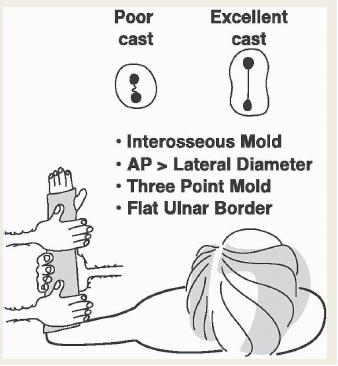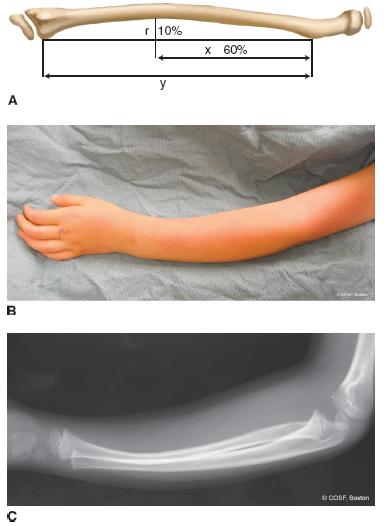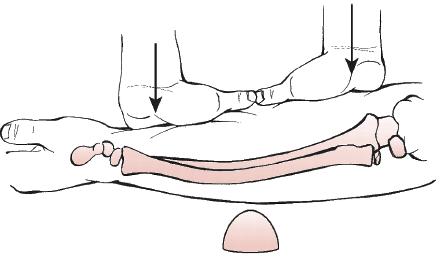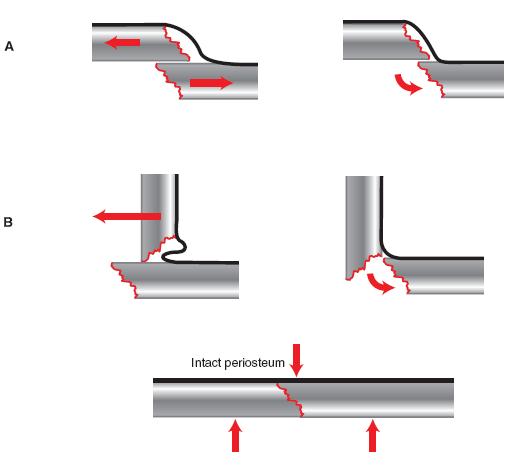FIGURE 33-1 Anteroposterior (AP) and lateral radiographs of a grade I open forearm fracture in a 10-year-old male.
Molds and Burns: The Lost Art of Casting
Pediatric hand and upper extremity surgeons must not only possess surgical skill but also expertise in nonoperative fracture care. In the age of emerging technologies and increasing choice of surgical approaches, implants, and techniques, the merits of cast immobilization cannot and should not be forgotten. Indeed, perhaps more important than techniques of achieving reduction or methods of internal fixation is proper cast application.
In appropriate patients, successful closed treatment of diaphyseal forearm fractures involves application of a well-molded cast. As Mercer Rang and others have taught us, there are several elements to a properly molded cast (Figure 33-2). First, a three-point bending mold should be applied to maintain angular correction. Second, an interosseous mold should be applied to preserve the interosseous space, with care taken to ensure that the AP diameter is greater than the lateral. Third, a straight ulnar border should be maintained to ensure ulnar alignment and an acceptable aesthetic result. Finally, a supracondylar mold above the flexed elbow will help to prevent cast migration, particularly in the very young patient.

FIGURE 33-2 Schematic diagram of the elements needed for effective cast immobilization. (From Wenger DR, Pring ME. Rang’s Children’s Fractures. 3rd ed. Philadelphia, PA: Lippincott Williams & Wilkins; 2005.)
Any cast applied will eventually need to be removed, and often a cast will need to be bivalved shortly after application to accommodate soft tissue swelling. While seemingly straightforward, cast removal may result in lacerations or thermal injuries during inappropriate cast saw use.56–59 In the pediatric population, risk is particularly high, as casts are bivalved or removed in the nonverbal, sedated, or anesthetized patient, who cannot communicate pain or discomfort. This is an entirely preventable complication and one we feel should never occur.
Both common sense and published information inform us that cast saw injuries may be avoided by a number of simple preventative interventions. Adequate cast padding of at least three to four layers should always be applied. When applying plaster casting material, excessive thickness and higher ambient dip water temperatures (>24°C) should be avoided. Sufficient time should be allotted to allow plaster material to cure and cool before fiberglass material is over-wrapped. Oscillating cast saws should be kept sharp, with frequent cooling during use to avoid thermal skin injury. With these simple steps, cast saw injuries may be prevented.
Clinical Evaluation
Patients will present with pain, swelling, deformity, and limited forearm motion. Circumferential inspection of the limb should be made to assess for wounds or lacerations suggestive of open fractures. Palpation and evaluation of the elbow and wrist should similarly be performed, as tenderness or deformity may indicate adjacent joint injury or concomitant fractures. The vascular and neurological status should be systematically examined to rule out associated vascular injury, nerve palsy, or impending compartment syndrome.7–9
Standard AP and lateral radiographs of the entire forearm are performed in all cases of suspected forearm fracture and will confirm the diagnosis. Systematic evaluation of the wrist and elbow should be performed, even in the setting of known bony injuries. Information regarding rotational alignment of the radius and ulna can be derived from the position of bony landmarks. On AP projections, the radial styloid lies 180 degrees opposite the bicipital tuberosity; on the lateral projection, the ulnar styloid is also positioned 180 degrees from the coronoid process. Even using these radiographic landmarks, malrotation is difficult to quantify using radiographic indices and may be within 45 degrees of accuracy.10,11
Forearm fractures are classified according to anatomic location (proximal, middle, or distal thirds), fracture displacement and angulation, and fracture pattern. In general, three patterns occur in skeletally immature patients: plastic deformation injuries, greenstick (incomplete) fractures, and complete fractures. Each fracture pattern has its unique anatomic features and treatment considerations.
Radiographically, plastic deformation, or traumatic bowing, presents as bones that are “bent but not broken.”12 Typically affecting younger patients under 10 years of age, there is often little clinical deformity, swelling, ecchymosis, and/or tenderness. Forearm rotation, however, will be limited. Radiographic findings may be subtle, characterized by abnormal curvature of the radial and/or ulnar shafts in association with narrowing of the interosseous space. An understanding of the normal radiographic appearance of the radius and ulna, and in particular the normal radial bow, is imperative in identifying plastic deformation injuries13 (Figure 33-3). Depending on the severity of the plastic deformation, the physical exam in patients with these injuries ranges from subtle motion and aesthetic differences, to a block to rotational motion, and an S-shaped forearm grossly. Identification of the injuries with limited motion acutely is important for a positive long-term outcome.
Greenstick, or incomplete, fractures result from torsional and bending injuries in younger children. Radiographically, one cortex is disrupted while the other cortex remains intact or is plastically deformed. Due to the inherent stability conferred by the intact cortex, closed reduction and cast immobilization remain the standard of care.
Complete fractures are those in which there is complete cortical disruption. These injuries are akin to their adult counterparts in mechanism of injury, clinical presentation, and radiographic appearance.
Because the ulna is subcutaneous in location and straight in alignment, ulnar deformity results in aesthetic differences. Conversely, radial malalignment is less visible but results in loss of forearm rotation. While loss of pronation is well compensated for by shoulder abduction, forearm supination loss is poorly tolerated due to the blocking effect of the thorax with attempted shoulder adduction to bring the palm in an upward position.11 Multiple published series have demonstrated that diaphyseal fracture malunions contribute to loss of forearm rotation and functional impairment.11,14–16 Cadaveric studies have demonstrated that <10 degrees of angulation results in little if any loss of forearm rotation. Greater than 10 degrees of angulation will proportionally impede forearm rotation. More proximal bony deformity will impart greater restrictions in forearm rotation. As a result, less angular deformity is tolerated in more proximal than more distal fractures. Malrotation, while difficult to quantify radiographically, similarly causes loss of forearm rotation.17,18 Indeed, for every degree of rotational deformity, 1 to 2 degrees of forearm rotation may be lost. In general, ulnar malrotation does not alter the overall arc of forearm rotation but does change the “set point” of forearm motion. Radial malrotation, on the other hand, does reduce the overall arc of forearm supination pronation. Ultimately, however, clinical forearm rotation and radiographic alignment are poorly correlated.19

FIGURE 33-3 A: Schematic diagram of the normal radiographic bow of the radius. B: Clinical photograph of a patient with plastic deformation of the forearm. C: Corresponding radiograph depicting the traumatic bowing.
Additional consideration must be made for bony remodeling. With fracture healing and subsequent skeletal growth, a number of bony changes occur. The adjacent physis is reoriented. The bone continues to elongate, reducing the apparent angular deformity. And finally, appositional periosteal bone formation, typically at the concavity of the deformity, serves to “correct” angulation and displacement. Clearly, remodeling potential is greatest in younger patients, in fractures closer to the adjacent physis, and with deformity in the plane of adjacent joint motion. In general, up to 20 degrees of diaphyseal angulation may remodel in children under 8 years of age. Beyond the age of 10 years, however, more than 10 degrees of angulation is not likely to remodel spontaneously.
The available published information provides guidelines as to how much radiographic deformity can be expected to remodel with continued skeletal growth. Up to 1 cm of shortening may be accepted with little impact on forearm rotation, perhaps due to relaxation of the inter-osseous membrane.11,20 Complete or 100% translation may remodel in younger patients in fractures of the middle and distal thirds.10,11,20 Radioulnar angulation is less well tolerated, due to narrowing of the interosseous space and bony impingement during forearm rotation. Mehlman and Wall3 have proposed the “20-15-10” rule to guide what constitutes acceptable angulation in radius and ulna fractures. Dividing the forearm into thirds, 20, 15, and 10 degrees of angulation may be accepted in the distal, middle, and proximal thirds of the forearm, respectively.
In addition to angulation, displacement, and translation, other tools have been proposed to predict the final position and ultimate outcomes of diaphyseal forearm fractures.21,22 Younger et al. have proposed that axis deviation be utilized to predict outcomes following forearm diaphyseal fractures and thus to guide when closed reduction or surgical intervention is required (Figure 33-4). Axis deviation is defined as the distance between the fractured and anatomical axes of the bone measured at the fracture site, divided by the total length of the bone multiplied by 100. An axis deviation of >5 at the time of bony healing (i.e., cast removal) has been correlated with restricted forearm motion even after completion of skeletal growth and bony remodeling. The advantages of the axis deviation index are that it eliminates variables associated with vagaries of radiographic projection, magnification, and fracture location and does not rely strictly on radiographic angulation or translation to predict functional loss.
As clinical motion does not directly correlate with radiographic alignment, a more important question is “how much bony deformity can still allow for reasonable functional outcomes?” Historically, up to 10 degrees of angulation, complete translation, and 30 to 45 degrees of malrotation were thought to be well tolerated without functional limitations.11 These parameters should be considered carefully, particularly given the patient and family expectations for restoration of full forearm rotation.
Surgical Indications
We make a living by what we get, but we make a life by what we give.
—Winston Churchill
The goals of diaphyseal forearm fracture treatment are to achieve bony healing, preserve forearm motion, prevent aesthetically displeasing deformity, and avoid complications.16,19,23,24
With this in mind, closed reduction should be considered in all acute displaced diaphyseal forearm fractures. Surgical indications include open forearm fractures, floating elbow injuries, fractures with vascular injury, fractures with soft tissue swelling precluding circumferential cast immobilization, and irreducible or unstable fractures with deformity beyond what would be anticipated to remodel, given the fracture pattern and patient age. Diaphyseal forearm refracture is considered a relative indication for surgery.
Although there are a host of surgical options, percutaneous pinning is generally insufficient, and external fixation is used most commonly in grade III open fractures and fractures with vascular impairment.25 Currently, most forearm diaphyseal fractures are treated with intramedullary (IM) fixation or internal fixation with plate and screw constructs.
SURGICAL PROCEDURES
 Closed Reduction of Incomplete Fractures
Closed Reduction of Incomplete Fractures
Closed reduction should be performed for all plastic deformation injuries with >20 degrees of angulation in patients over 4 years of age, given the limited remodeling potential.12,26,27 Although seemingly straightforward, forces as high as 30 kg sustained over several minutes are required to correct traumatic bowing.26 As a result, controlled three-point bending over a sandbag, rolled towel, or the clinician’s thigh should be performed under general anesthesia or well-administered conscious sedation (Figure 33-5). Following closed manipulation, fluoroscopy may be used to check bony alignment and restoration of passive forearm rotation. A well-molded long-arm cast is applied, which is critical for maintenance of reduction (see Sidebar). Casts should be applied with a straight ulnar border, interosseous mold, and three-point molding over the apex of the deformity.3 Although well-molded casts may be aesthetically displeasing to the patient and family, “curved plaster is necessary in order to make a straight limb.”28 With appropriate reduction and casting, up to 85% deformity correction may be achieved.

FIGURE 33-4 Schematic diagram of axis deviation.

FIGURE 33-5 Schematic diagram depicting the technique of closed reduction for a plastic deformation injury.
In very rare situations, excessive plastic deformation cannot be adequately corrected despite vigorous attempts at closed reduction. If the diaphyseal bowing is excessive and impedes forearm rotation, percutaneous pin osteoclasis at the apex of the deformity may be performed, followed by correction of longitudinal alignment and appropriate cast immobilization. In essence, this technique surgically converts a plastic deformation injury into an incomplete or complete fracture to facilitate reduction.
Displaced greenstick fractures are also treated with closed reduction and cast immobilization (Figure 33-6). Closed reduction is performed by reversing the rotational deformity followed by correction of the angulation. In general, apex dorsal fractures are caused by hyperpronation and therefore are reduced with forearm supination.3 Conversely, apex volar fractures are due to hypersupination and are best reduced with pronation. The “rule of thumbs”—in which the thumb is rotated toward the apex of the deformity—has been proposed to guide care providers about the appropriate reduction maneuver. For example, in the common apex volar angulated fracture, rotating the thumb pronates the distal fracture fragment, thus correcting the hypersupination injury. Just be certain you assess the thumb position in the adducted shoulder position to avoid misinterpreting shoulder motion for forearm rotation. In situations where the radius and ulna are fractured at the same level, pure bending is more likely to be the mechanism of injury, and reduction may thus be achieved with simple three-point molding. A well-fitting cast with appropriate interosseous and three-point mold is then applied in maintaining fracture reduction during bony healing. Controversy persists regarding whether the greenstick fracture should be completed (i.e., the intact cortex broken) during fracture manipulation. The advantages of fracture completion include greater ease of reduction and lower refracture rate due to the exuberant periosteal fracture callus formation that ensues. Disadvantages of fracture completion include greater fracture instability and difficulty in achieving and maintaining bony alignment during cast immobilization.

FIGURE 33-6 Radiograph depicting greenstick fractures of the radius and ulna.
In patients with complete fractures of the radius and ulna diaphyses and unacceptable deformity, closed reduction is performed under conscious sedation. Fracture reduction is performed by first exaggerating the deformity to unlock and relax the intact periosteum, followed by longitudinal traction, correction of rotational malalignment, and finally reversal of the angular deformity (Figure 33-7). A long-arm cast with appropriate interosseous and three-point bending mold is then applied.
The optimal position of cast immobilization remains controversial. While the vast majority of casts are applied with the elbow flexed 90 degrees, long-arm extension casts have been used, particularly for proximal third fractures with apex posterior or apex ulnar angulation29 (Figure 33-8). The addition of a thumb spica component and placement of a D-ring with neck strap on the extension cast help prevent the cast from sliding distally off the limb with walking and in the upright position.
The optimal position of forearm rotation is even more debatable. Theoretically, proximal one-third fractures of the radius are better immobilized in supination; this rotates the distal fragment into alignment with the proximal fragment, which is supinated by the action of the biceps and supinator muscles. Mid-diaphyseal fractures occurring proximal to the insertion of the pronator may be better immobilized with the distal segment supinated, again matching rotational alignment. Conversely, fractures distal to the pronator insertion on the radius may be best immobilized in neutral rotation or forearm pronation.
 Irrigation and Debridement of Open Fractures
Irrigation and Debridement of Open Fractures
The forearm is among the most common sites for open fractures in children.1 While unlikely, potentially devastating infectious complications can occur, even with seemingly innocuous grade I open fractures25,30 (Figure 33-9). Timely irrigation and debridement in the operating room, combined with prophylactic antibiotics and fracture reduction and stabilization, is the standard of care for all open forearm fractures.31 While there is a wealth of adult trauma literature to suggest open fractures are not a surgical emergency provided antibiotic prophylaxis is given, our preference is to treat open fractures as soon as possible after presentation. While waiting for the operating room, the wound is inspected, sterilely dressed, appropriate intravenous antibiotics and tetanus prophylaxis are given, and the limb is splinted.
Irrigation and debridement are the standard of care. This entails more than simple lavage of the superficial wound. Contaminated or nonviable skin edges from the traumatic wound are debrided and the surgical incision extended to allow for adequate visualization of the zone of injury and fracture fragments. Careful inspection and debridement of the bony ends are essential, as often there are contamination and foreign material within the IM canal of the fracture fragments.32 After adequate wound care, direction may be turned to fracture management.

FIGURE 33-7 Schematic diagram depicting the technique of closed reduction. A: Although the cortical break is complete, the intact periosteum will prevent cortical apposition with straight longitudinal traction alone. B: To effectuate a reduction, the deformity must first be exaggerated, followed by longitudinal traction, and finally reversal of the deformity. Three-point molding may then take advantage of the stability conferred by the intact periosteum.
Stay updated, free articles. Join our Telegram channel

Full access? Get Clinical Tree


